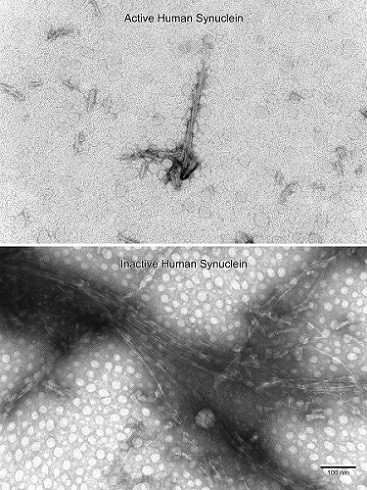Recombinant Human Alpha-synuclein protein aggregate (Active) (ab218819)
Key features and details
- Expression system: Escherichia coli
- Purity: > 95% SDS-PAGE
- Endotoxin level:
- Active: Yes
- Suitable for: WB, Functional Studies, SDS-PAGE
Preparation and Storage
-
Stability and Storage
Shipped on Dry Ice. Store at -80°C. Avoid freeze / thaw cycle.
Constituent: PBS
This product is an active protein and may elicit a biological response in vivo, handle with caution.
Images
-
 Immunohistochemistry (Formalin/PFA-fixed paraffin-embedded sections) - Recombinant human Alpha-synuclein protein aggregate (Active) (ab218819)
Immunohistochemistry (Formalin/PFA-fixed paraffin-embedded sections) - Recombinant human Alpha-synuclein protein aggregate (Active) (ab218819)Immunohistochemical analysis of primary rat hippocampal neurons showing lewy body inclusion formation when treated with active Alpha Synuclein Protein Aggregate (ab218819) at 4 µg/ml (D-F), but not when treated with control Alpha Synuclein Protein Aggregate (ab218817) at 4 µg/ml (A-C). Tissue: Primary hippocampal neurons. Species: Sprague-Dawley rat. Fixation: 4% formaldehyde from PFA. Primary antibody: Mouse anti-pSer129 Antibody at 1/1000 24 hours at 4°C. Secondary antibody: FITC Goat Anti-Mouse (green) at 1/700 for 1 hour at RT. Counterstain: Hoechst (blue) nuclear stain at 1/4000 for 1 hour at RT. Localization: Lewy body incluscions. Magnification: 20x.
-
ab218819 seeds the formation of new alpha synuclein fibrils from the pool of alpha synuclein monomers.
Thioflavin T is a fluorescent dye that binds to beta sheet-rich structures, such as those in alpha synuclein fibrils. Upon binding, the emission spectrum of the dye experiences a red-shift, and increased fluorescence intensity.
Thioflavin T emission curves show increased fluorescence (correlated to alpha synuclein protein aggregation) over time when 10 µM of ab218819 is combined with 100 µM of alpha synuclein monomer, as compared to ab218819 alone and alpha synuclein monomer alone.
Thioflavin T ex = 450 nm, em = 485 nm.
-
TEM of active human alpha synuclein preformed fibrils (ab218819). Fibrils were sonicated and treated with uranyl acetate.
-
SDS-PAGE analysis of ab218819.
-
 Immunohistochemistry (Formalin/PFA-fixed paraffin-embedded sections) - Recombinant human Alpha-synuclein protein aggregate (Active) (ab218819)
Immunohistochemistry (Formalin/PFA-fixed paraffin-embedded sections) - Recombinant human Alpha-synuclein protein aggregate (Active) (ab218819)Immunohistochemistry analysis of rat brain injected with active human alpha synuclein PFFs (ab218819). Species: Female Sprague-Dawley Rat. Rat was injected with 2µL active human alpha synuclein PFFs (ab218819) in each of 2 injection sites: AP+1.6, ML+2.4, DV-4.2 from skull; and AP-1.4, ML+0.2, DV-2.8 from skull. 30-days post-injection. Fixation: Saline perfusion followed by 4% PFA fixation for 48 hrs. Secondary Antibody: Biotin-SP Donkey Anti-Rabbit IgG (H+L) at 1:500 for 2 hours in cold room with shaking. ABC signal amplification, DAB staining. Alpha synuclein pathology is seen in the striatum close to an injection site.
-
TEM of ab218819.
-
TEM of active human alpha synuclein preformed fibrils (ab218819) (top) and control (inactive) human alpha synuclein preformed fibrils (ab218817) (bottom). Fibrils were sonicated and treated with uranyl acetate. The active fibrils are shorter than the inactive fibrils.
-
ThT emission curves show increased fluorescence (correlated to alpha-synucleinprotein aggregation) over time when 10 µM of active alpha-synuclein aggregate (ab218819) is combined with 100 µM of active alpha-synuclein monomer (ab218818) (light blue), as compared to when 100 µM of active alpha-synuclein monomer is combined with 10 µM of control alpha-synuclein aggregate (purple line), or 100 µM of control alpha-synuclein monomer (ab218816) is combined with 10 µM of control alpha-synuclein aggregate (ab218817) (dark blue). ThT ex = 450 nm, em = 485 nm. View protocol.
-
TEM of active human alpha synuclein preformed fibrils (ab218819) (top) and control (inactive) human alpha synuclein preformed fibrils (ab218817) (bottom). Fibrils were sonicated and treated with uranyl acetate. The active fibrils are shorter than the inactive fibrils.





























